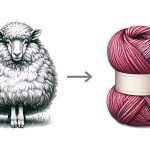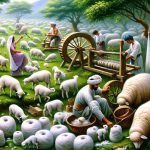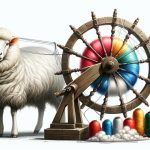Have you ever wondered how that cozy merino wool sweater you love is made? In this article, we’ll take you through the fascinating journey of how merino wool becomes a fabric.
You’ll discover the origins of merino wool, witness the sheep shearing and wool sorting process, learn about the crucial steps of cleaning, carding, and spinning the fibers into yarn, and finally witness the weaving or knitting process that brings it all together.
So, sit back, relax, and let’s dive into the world of merino wool production.
Table of Contents
The Origin of Merino Wool
Merino wool is sourced from Merino sheep, which are known for their soft and fine fleece. The origin exploration of Merino wool dates back to ancient times. Historical records show that the Merino sheep breed originated in Spain, specifically in the region of Extremadura. The Spanish royal family played a significant role in the development of the Merino breed, as they recognized the value of their luxurious fleece.
During the 18th century, Spanish Merino sheep were in high demand, and their exportation was strictly controlled. This led to the smuggling of Merino sheep and the establishment of Merino flocks in other countries, including France and Australia. The historical significance of Merino wool lies in its role as a valuable commodity and its impact on the textile industry.
Today, Merino wool is produced in various countries worldwide, including Australia, New Zealand, South Africa, and the United States. The exploration of its origin and subsequent breeding has resulted in different strains of Merino sheep, each with its own unique characteristics and fleece quality.
The historical significance of Merino wool cannot be understated, as it has become synonymous with luxury and comfort in the textile industry.
Sheep Shearing and Wool Sorting
When you’re shearing sheep, make sure you carefully sort the different types of wool. This is an important step in the wool production process, as it ensures that the wool is of the highest quality and can be used for various purposes. The sheep shearing techniques vary depending on the type of sheep and the desired outcome. Some common techniques include blade shearing, machine shearing, and hand shearing. After the sheep have been sheared, the wool is then sorted based on its quality and characteristics. This is where the wool grading system comes into play.
| Grade | Description |
|---|---|
| Fine | Soft, lightweight, and highly insulating. Used for luxury garments and accessories. |
| Medium | Versatile and durable. Used for a wide range of products such as sweaters, blankets, and socks. |
| Coarse | Sturdy and strong. Used for upholstery, carpets, and other heavy-duty applications. |
| Cotts | Short and coarse fibers. Typically used in felting and insulation. |
Cleaning and Scouring the Wool
After shearing the sheep, you’ll want to make sure you properly clean and scour the wool to remove any impurities and prepare it for further processing. Here’s a step-by-step process to guide you through the cleaning process of wool scouring:
-
Sorting: Separate the different types of wool, such as fleece, belly wool, and leg wool, to ensure a consistent quality throughout the batch. This step helps to remove any coarse or damaged fibers.
-
Pre-washing: Gently wash the wool with lukewarm water to remove dirt, grease, and sweat. This initial rinse helps to loosen and dissolve any impurities before the main scouring process.
-
Scouring: Immerse the wool in a scouring bath, typically consisting of a mild detergent or soap, at a controlled temperature. Agitate the wool gently to remove any remaining impurities, such as lanolin and vegetable matter. Rinse thoroughly to ensure all detergent is removed.
-
Drying: After scouring, carefully squeeze out excess water from the wool. Spread it out on a clean surface or hang it up to air dry. Avoid direct sunlight or excessive heat, as this can cause damage to the fibers.
Carding and Combing the Fibers
To achieve smooth and aligned fibers, you’ll need to card and comb the wool before moving on to the next step in the process. Carding and combing are essential techniques used in the production of wool fabric.
Carding involves using carding brushes or carding machines to separate and align the wool fibers. This process helps to remove any tangles, dirt, or debris from the wool. It also helps to blend different types of fibers together for a more consistent fabric.
Once the wool has been carded, it is then combed. Combing further refines the fibers, removing shorter and coarser fibers, resulting in a more uniform and fine quality yarn. Combing also helps to align the fibers in the same direction, which is important for spinning the yarn.
Carding and combing are crucial steps in the wool production process as they ensure that the fibers are prepared and ready for spinning. These techniques not only help to create a smoother and more even yarn, but they also improve the overall quality of the fabric. By blending different fibers together, carding also allows for the creation of unique and interesting textures.
Spinning and Twisting Into Yarn
Now that you understand how merino wool is transformed into a fabric through carding and combing, let’s delve into the next step of the yarn creation process: spinning and twisting.
In this discussion, we will explore the various spinning techniques used to transform the fibers into yarn, explaining the mechanics behind each method.
Yarn Creation Process
First, you’ll need to spin the merino wool fibers into yarn using a spinning wheel or machine. This process helps to transform the loose fibers into a strong and continuous strand of yarn.
Merino wool is known for its excellent yarn properties, such as its softness, elasticity, and moisture-wicking abilities.
Once the yarn is created, it can be dyed using various techniques. Dyeing can be done before or after the yarn is spun, depending on the desired effect. Some common dyeing techniques include hand-painting, dip-dyeing, and space-dyeing. These techniques allow for a wide range of colors and patterns to be applied to the yarn, giving it a unique and vibrant appearance.
With the yarn created and dyed, it is now ready to be transformed into a beautiful fabric.
Spinning Techniques Explained
If you want to learn spinning techniques, you can try using a drop spindle or a spinning wheel. These techniques have their own advantages and variations that can help you create beautiful yarn.
Here are three sub-lists to give you a clearer picture:
-
Drop Spindle:
-
Portable and easy to carry around.
-
Great for beginners due to its simplicity.
-
Allows you to control the thickness and twist of the yarn.
-
Spinning Wheel:
-
Faster than using a drop spindle.
-
Provides consistent tension and twist.
-
Allows for more complex techniques like plying and cabling.
-
Variations:
-
Supported Spindle: Rests on a surface to aid in spinning.
-
Electric Spinner: Uses a motor for faster spinning.
-
Navajo Spindle: Known for creating long, continuous yarn.
The Weaving or Knitting Process
Once the merino wool fibers are processed, they can be woven or knitted into a fabric. The weaving process involves interlacing the fibers together to create a stable and durable fabric. There are various weaving techniques that can be used, each resulting in a different pattern and texture. Some common weaving techniques include plain weave, twill weave, and satin weave.
In plain weave, the weft and warp threads are interlaced in a simple over-under pattern, creating a balanced and strong fabric. Twill weave, on the other hand, involves a diagonal pattern, resulting in a durable and drapable fabric. Satin weave, known for its lustrous appearance, has long floats on the surface, giving the fabric a smooth and shiny finish.
Knitting, on the other hand, involves interlocking loops of yarn to create a fabric. There are various knitting patterns that can be used to achieve different textures and designs. Some common knitting patterns include garter stitch, stockinette stitch, and rib stitch.
Finishing and Treating the Merino Wool Fabric
In this section, we’ll discuss how to enhance the durability and softness of your merino wool fabric. You’ll learn about the various finishing processes that can be used to achieve these desired qualities.
Additionally, we’ll explore eco-friendly alternatives to traditional finishing methods. This way, we can ensure that your fabric is not only long-lasting and comfortable but also environmentally conscious.
Enhancing Durability and Softness
To enhance durability and softness, merino wool is treated with special enzymes. These enzymes break down the outer layer of the wool fibers, resulting in a smoother and more refined texture. This process also helps to increase the moisture wicking performance of the fabric, allowing it to efficiently absorb and release moisture, keeping you dry and comfortable.
Enzyme treatment: Merino wool is soaked in a solution containing enzymes that break down the outer layer of the wool fibers.
Softening: The enzyme treatment helps to soften the wool, making it feel even more luxurious against your skin.
Durability: By breaking down the outer layer, the enzymes also help to strengthen the wool fibers, making the fabric more durable and resistant to wear and tear.
In addition to enhancing the performance and comfort of merino wool, these enzyme treatments contribute to the sustainability of the production process. The use of enzymes reduces the need for harsh chemicals and energy-intensive processes, making merino wool a more environmentally friendly choice.
Eco-Friendly Finishing Processes
When considering eco-friendly finishing processes, you’ll be pleased to know that enzymes play a significant role in reducing the need for harsh chemicals and energy-intensive methods.
These enzymes are used in eco-friendly dyeing methods to enhance the sustainability of fabric production. By using enzymes, the need for chemical dyes and harmful substances is minimized, leading to a more environmentally friendly process.
Enzymes act as catalysts, breaking down chemical bonds and facilitating the dyeing process without the need for excessive energy consumption. This not only reduces the carbon footprint associated with fabric production but also improves the overall sustainability of the industry.
Sustainable fabric production is crucial in minimizing the negative impact on the environment, and enzymes are a key tool in achieving this goal.
Conclusion
In conclusion, you now have a clear understanding of how merino wool becomes a fabric.
You have learned about the origin of merino wool, the process of sheep shearing and wool sorting, followed by the cleaning and scouring of the wool.
Then, the fibers are carded and combed before being spun and twisted into yarn.
Finally, the fabric is created through weaving or knitting, and finishing and treating processes.
It’s fascinating to see how this natural material is transformed into a versatile and luxurious fabric.
- Choosing the Right Fabrics for Babies - July 20, 2024
- Impact of Fabrics on Skin Health - July 20, 2024
- Benefits of Antimicrobial Fabrics - July 20, 2024







